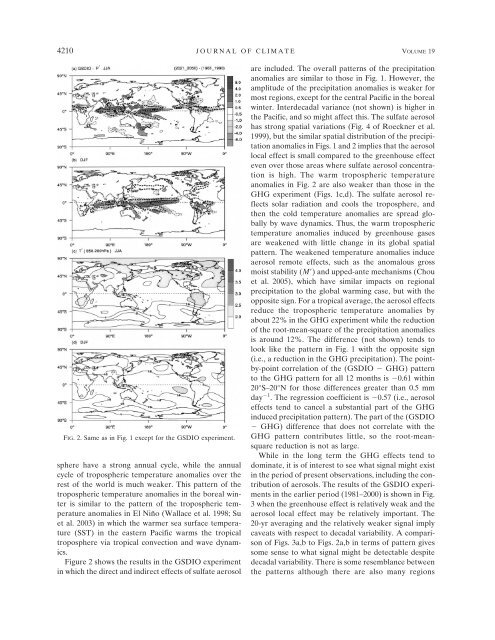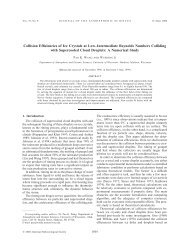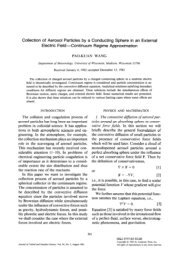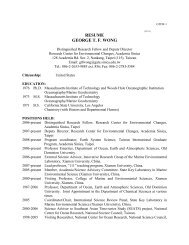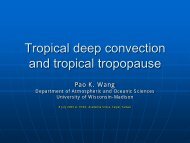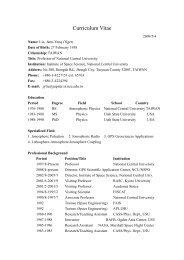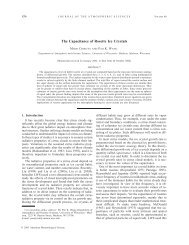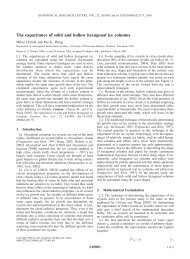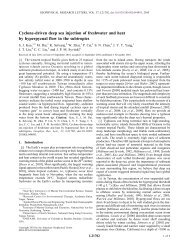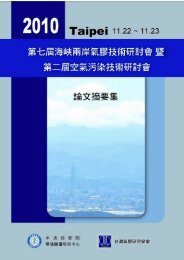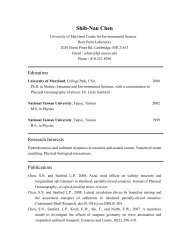Regional Tropical Precipitation Change ... - Academia Sinica
Regional Tropical Precipitation Change ... - Academia Sinica
Regional Tropical Precipitation Change ... - Academia Sinica
Create successful ePaper yourself
Turn your PDF publications into a flip-book with our unique Google optimized e-Paper software.
4210 JOURNAL OF CLIMATE VOLUME 19<br />
FIG. 2. Same as in Fig. 1 except for the GSDIO experiment.<br />
sphere have a strong annual cycle, while the annual<br />
cycle of tropospheric temperature anomalies over the<br />
rest of the world is much weaker. This pattern of the<br />
tropospheric temperature anomalies in the boreal winter<br />
is similar to the pattern of the tropospheric temperature<br />
anomalies in El Niño (Wallace et al. 1998; Su<br />
et al. 2003) in which the warmer sea surface temperature<br />
(SST) in the eastern Pacific warms the tropical<br />
troposphere via tropical convection and wave dynamics.<br />
Figure 2 shows the results in the GSDIO experiment<br />
in which the direct and indirect effects of sulfate aerosol<br />
are included. The overall patterns of the precipitation<br />
anomalies are similar to those in Fig. 1. However, the<br />
amplitude of the precipitation anomalies is weaker for<br />
most regions, except for the central Pacific in the boreal<br />
winter. Interdecadal variance (not shown) is higher in<br />
the Pacific, and so might affect this. The sulfate aerosol<br />
has strong spatial variations (Fig. 4 of Roeckner et al.<br />
1999), but the similar spatial distribution of the precipitation<br />
anomalies in Figs. 1 and 2 implies that the aerosol<br />
local effect is small compared to the greenhouse effect<br />
even over those areas where sulfate aerosol concentration<br />
is high. The warm tropospheric temperature<br />
anomalies in Fig. 2 are also weaker than those in the<br />
GHG experiment (Figs. 1c,d). The sulfate aerosol reflects<br />
solar radiation and cools the troposphere, and<br />
then the cold temperature anomalies are spread globally<br />
by wave dynamics. Thus, the warm tropospheric<br />
temperature anomalies induced by greenhouse gases<br />
are weakened with little change in its global spatial<br />
pattern. The weakened temperature anomalies induce<br />
aerosol remote effects, such as the anomalous gross<br />
moist stability (M) and upped-ante mechanisms (Chou<br />
et al. 2005), which have similar impacts on regional<br />
precipitation to the global warming case, but with the<br />
opposite sign. For a tropical average, the aerosol effects<br />
reduce the tropospheric temperature anomalies by<br />
about 22% in the GHG experiment while the reduction<br />
of the root-mean-square of the precipitation anomalies<br />
is around 12%. The difference (not shown) tends to<br />
look like the pattern in Fig. 1 with the opposite sign<br />
(i.e., a reduction in the GHG precipitation). The pointby-point<br />
correlation of the (GSDIO GHG) pattern<br />
to the GHG pattern for all 12 months is 0.61 within<br />
20°S–20°N for those differences greater than 0.5 mm<br />
day 1 . The regression coefficient is 0.57 (i.e., aerosol<br />
effects tend to cancel a substantial part of the GHG<br />
induced precipitation pattern). The part of the (GSDIO<br />
GHG) difference that does not correlate with the<br />
GHG pattern contributes little, so the root-meansquare<br />
reduction is not as large.<br />
While in the long term the GHG effects tend to<br />
dominate, it is of interest to see what signal might exist<br />
in the period of present observations, including the contribution<br />
of aerosols. The results of the GSDIO experiments<br />
in the earlier period (1981–2000) is shown in Fig.<br />
3 when the greenhouse effect is relatively weak and the<br />
aerosol local effect may be relatively important. The<br />
20-yr averaging and the relatively weaker signal imply<br />
caveats with respect to decadal variability. A comparison<br />
of Figs. 3a,b to Figs. 2a,b in terms of pattern gives<br />
some sense to what signal might be detectable despite<br />
decadal variability. There is some resemblance between<br />
the patterns although there are also many regions


